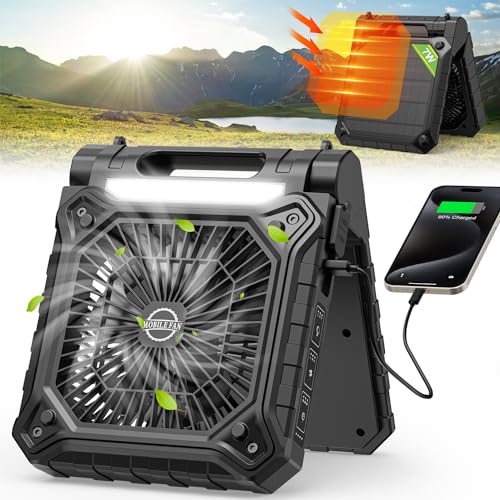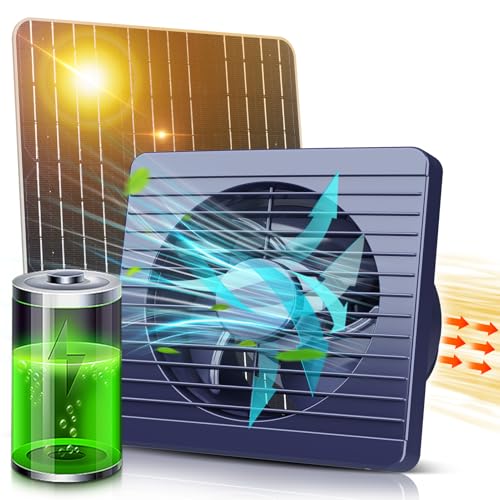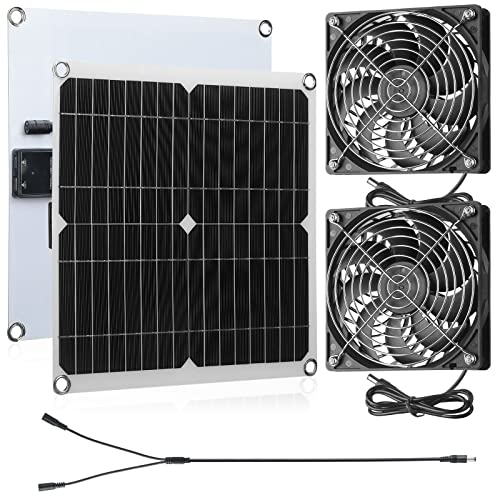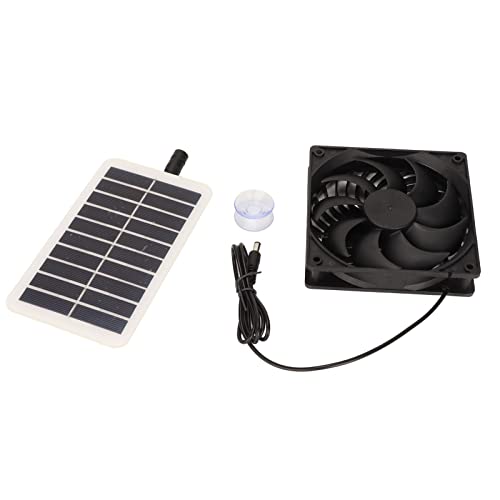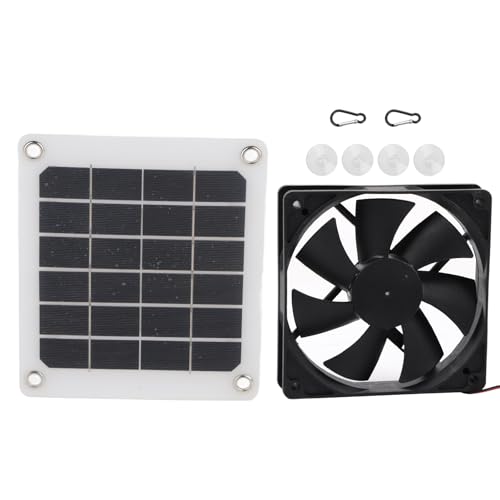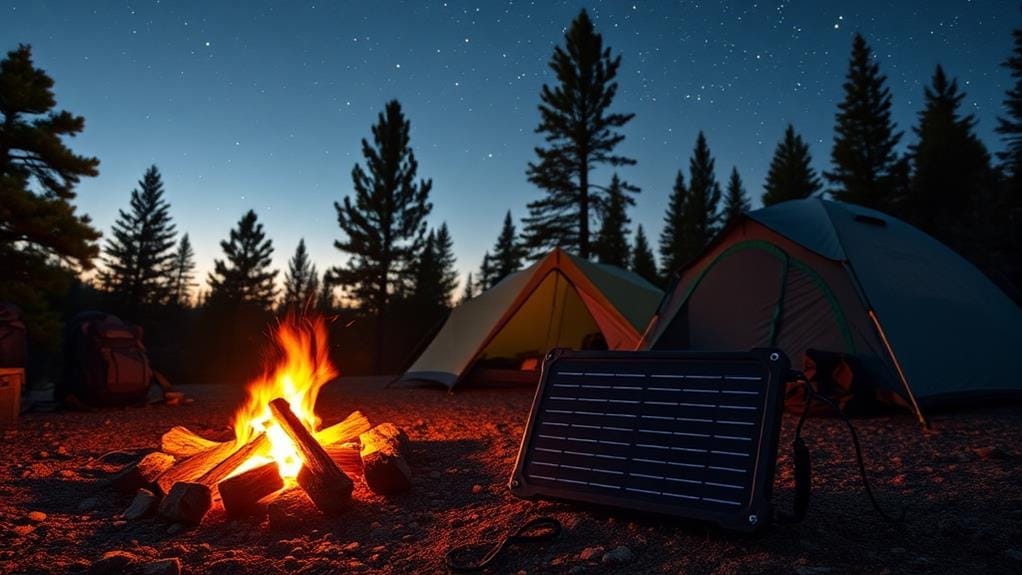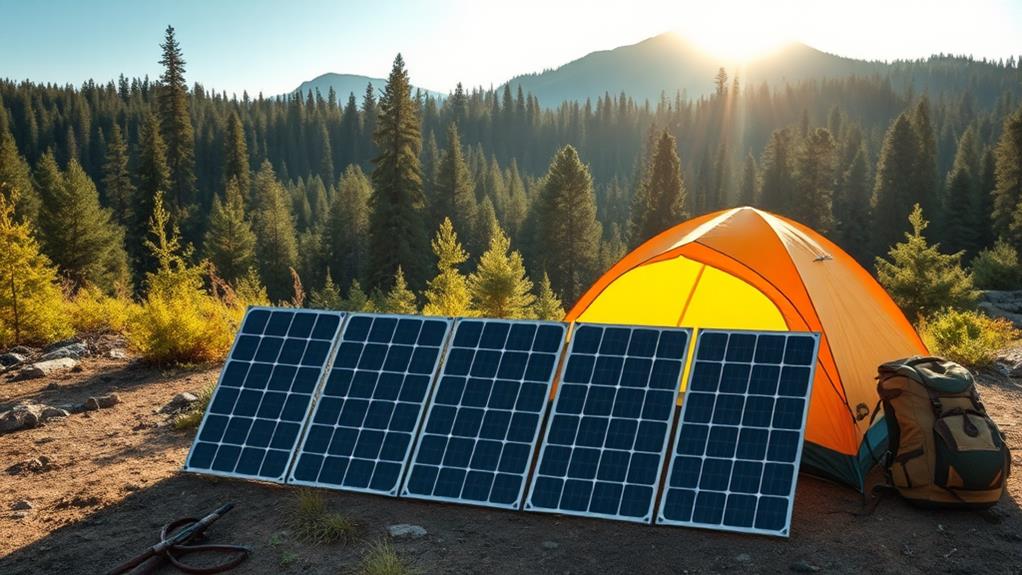When selecting solar-powered ventilators for eco-friendly cooling in 2025, you’ll find options ranging from 10W to 20W with varying features and applications. Top models include camping fans with LED lanterns, rechargeable 20W fans for chicken coops, and exhaust fan kits for outdoor use. Key considerations are power output (10-20W), battery capacity (6600-12000mAh), and ventilation performance (up to 115 CFM). Look for monocrystalline silicon panels for higher efficiency, and IPX7 or IP65 waterproof ratings for durability. Installation ease, portability, and noise levels (31-39 dB) are also significant factors. Prices typically range from $50 to $200, depending on specifications and performance. Further exploration will reveal additional technical details and selection criteria.
Key Takeaways
- Solar-powered ventilators offer eco-friendly cooling with zero operating costs, utilizing renewable energy for various applications.
- Top models feature high-capacity batteries (6600-12000mAh) for extended runtime and efficient solar panels for optimal energy conversion.
- Key considerations include airflow capacity (CFM), noise levels, durability, and additional features like LED lighting or USB charging.
- Installation ease and portability are important factors, with some models offering adjustable angles and multiple mounting options.
- Price range typically falls between $50-$200, with value determined by efficiency ratings, waterproof capabilities, and overall performance.








Solar Powered Camping Fan with LED Lantern and Rechargeable Battery
- ☀️【Professional Camping Gear】: Different from other portable fans on the market, this camping fan has a built-in solar panel and a 12000mAh...
- ☀️【Effciency Solar Panel】: The solar panel is made of monocrystalline silicon and utilizes sunlight to generate electricity. Fully charge a...
- ☀️【LED Camping Lantern】: This solar fan has 3 brightness settings, making it an ideal choose source for night camping or hiking. It also comes...
Last update on 2025-12-25 / Affiliate links / Images from Amazon Product Advertising API
Combining versatility with efficiency, the DOWILLDO Solar Powered Fan for Camping is ideal for outdoor enthusiasts who need a reliable, multi-functional device. This compact unit, weighing 2.2 pounds, features a 12000mAh rechargeable battery, a built-in monocrystalline silicon solar panel, and an LED lantern with three brightness settings. You’ll appreciate its 3-speed fan, which can operate for 9-38 hours on a full charge, and the energy-conserving timer options of 2H, 4H, and 6H. The fan’s rugged ABS housing guarantees durability in outdoor conditions, while its adjustable angles (30°, 60°, 90°) provide maximum airflow direction. Additionally, the unit serves as an emergency power source with USB and Type-C ports for charging devices. With a customer rating of 4.1/5 stars, this versatile fan ranks #183 in Personal Fans on Amazon.
Best For: Outdoor enthusiasts and campers seeking a versatile, solar-powered device that combines a fan, LED lantern, and power bank in one compact unit.
Pros:
- Long-lasting 12000mAh rechargeable battery with solar charging capability
- Multi-functional design with fan, LED lantern, and emergency power source
- Durable construction with adjustable angles and energy-saving timer options
Cons:
- Relatively heavy at 2.2 pounds, which may be a concern for ultralight backpackers
- Solar charging may be slow in less-than-ideal lighting conditions
- Limited customer reviews (only 42 ratings) may not provide a comprehensive assessment of long-term reliability
20W Rechargeable Solar Powered Fan for Chicken Coop and Greenhouse
Last update on 2025-12-25 / Affiliate links / Images from Amazon Product Advertising API
If you’re looking for a versatile and efficient solar-powered ventilator for small structures, the 20W Rechargeable Solar Powered Fan is an excellent choice. This 8-inch fan, equipped with a monocrystalline silicon solar panel and a 6600mAh battery, offers robust performance for chicken coops, greenhouses, and other outdoor structures. The panel’s 50% increased light absorption efficiency allows for a full charge in 6-8 hours, providing 8-12 hours of continuous operation. With an IPX7 waterproof rating and an imported high-speed motor, this fan guarantees powerful, quiet ventilation in various weather conditions. Installation flexibility is enhanced by two mounting options and a 10ft connection cable, while the backdraft valve and protective grille add safety features. The manufacturer offers a one-year warranty and 24/7 customer support, providing a reliable and efficient ventilation solution for your small-scale agricultural or residential needs.
Best For: Small-scale farmers, greenhouse owners, and pet owners seeking an eco-friendly, low-maintenance ventilation solution for their coops, greenhouses, or outdoor structures.
Pros:
- Efficient solar charging with 8-12 hours of operation on a full charge
- Versatile installation options with waterproof design for outdoor use
- Quiet operation with safety features like backdraft valve and protective grille
Cons:
- Performance may decrease in cloudy weather or with suboptimal panel positioning
- Limited to small-scale applications due to 8-inch fan size
- Initial cost may be higher compared to traditional non-solar fans
Riakrum 20W Solar Panel Exhaust Fan Kit for Outdoor Use
- Package Includes: you will receive 1 set of solar panel fan kit, including 1 piece of 20W 16V solar panel, and 2 pieces of exhaust fans, the nice...
- Reliable to Use: the solar panel with fan is compact, the solar panel is about 11 x 11 inches/ 28 x 28 cm, and the fan is about 4.7 x 4.7 inches/ 12 x...
- Quality Material: the solar panel of the solar exhaust fan is mainly made of monocrystalline silicon, and the fan adopts iron net and plastic housing,...
Last update on 2025-12-25 / Affiliate links / Images from Amazon Product Advertising API
For outdoor enthusiasts seeking a simple solar ventilation solution, the Riakrum 20W Solar Panel Exhaust Fan Kit offers a straightforward setup. This kit includes a 20W 16V monocrystalline silicon solar panel measuring 11 x 11 inches and two 4.7 x 4.7 inch exhaust fans. Operating exclusively in direct sunlight without power storage, the system can deliver a maximum air volume of 115.35 CFM. Installation is uncomplicated, utilizing an adapter cable to connect the panel to the fans, which run automatically when exposed to sunlight. While some users report effective heat reduction in greenhouses and for hardening seedlings, others have experienced inconsistent performance and durability issues. The kit’s lack of a controller and sensitivity to varying sunlight conditions may limit its reliability in certain applications.
Best For: DIY enthusiasts and hobbyists looking for a basic solar-powered ventilation solution for small outdoor structures like greenhouses or chicken coops.
Pros:
- Simple installation with no complex wiring or setup required
- Operates automatically in direct sunlight without the need for batteries
- Provides effective airflow for reducing heat in small enclosed spaces
Cons:
- Inconsistent performance and reliability issues reported by some users
- Lack of power storage limits functionality to daylight hours only
- No built-in controller for adjusting fan speed or operation
Solar Panel Fan Kit for Chicken Coops and Greenhouses (12W, 6 Inch)
- Our solar panel features advanced polyethylene coating technology and a polycrystalline solar chip. The surface is sealed with epoxy resin, providing...
- USB Compatibility:The solar fan is equipped with a double USB design, allowing it to be powered by either the solar panel or any USB-compatible...
- Solar Panel and USB Fan Sets:This solar fan includes a 12W solar panel, a 6-inch USB solar panel fan, a bracket,2 screws and 2 nuts. Whether used...
Last update on 2025-12-25 / Affiliate links / Images from Amazon Product Advertising API
Chicken coop and greenhouse owners will find the Solar Panel Fan Kit a versatile and eco-friendly ventilation solution. This 12W, 6-inch mini ventilator, measuring 9.33 x 9.33 x 0.67 inches and weighing 1.17 kg, is designed for various applications, including sheds, pet houses, and windows. The fan’s advanced polyethylene coating, polycrystalline solar chip, and epoxy resin sealing guarantee durability and scratch resistance. Operating at a low 31 dB noise level, it’s ideal for creating a comfortable environment for animals and plants.
The fan’s double USB design allows power input from both the solar panel and USB-compatible devices, offering flexibility in operation. However, users should note that the fan requires direct sunlight for peak performance and may slow down or stop in weak light conditions. With no built-in battery, an external power supply is necessary for use without sunlight. Despite this limitation, the fan’s high efficiency and plug-and-play functionality make it a practical addition for various indoor and outdoor settings.
Best For: Owners of chicken coops, greenhouses, or small outdoor structures seeking an eco-friendly, low-noise ventilation solution that doesn’t require electrical wiring.
Pros:
- Solar-powered operation reduces energy costs and environmental impact
- Versatile applications for various small structures and outdoor settings
- Low noise level (31 dB) ensures minimal disturbance to animals or plants
Cons:
- Requires direct sunlight for optimal performance, limiting effectiveness in shaded areas or cloudy weather
- Lack of built-in battery means no power storage for use during non-sunny periods
- May not provide sufficient airflow for larger spaces or during extreme heat conditions
FTVOGUE 15W Solar Power Panel Exhaust Fan for Pet Houses and RVs
- Energy Efficient: This solar exhaust fan uses clean solar energy to cut down on electricity use, helping you save energy while boasting a long service...
- Odor Elimination: Keep air clean and fresh with this solar exhaust fan—it effectively clears out unwanted odors, including those from pets. Whether...
- High Efficiency: Equipped with outdoor solar panels, this solar exhaust fan efficiently converts sunlight into electricity, ensuring reliable...
Last update on 2025-12-25 / Affiliate links / Images from Amazon Product Advertising API
Pet owners and RV enthusiasts seeking an eco-friendly ventilation solution will find the FTVOGUE 15W Solar Power Panel Exhaust Fan an excellent choice. This compact, solar-powered mini ventilator, measuring 12 x 12 x 2.5 cm, offers versatile applications for kitchens, greenhouses, pet houses, chicken coops, tree houses, and RVs. With its 15W monocrystalline silicon solar panel and ABS construction, the unit delivers an impressive air volume of 87.18 CFM at 2500±10% RPM, while maintaining a low noise level of 39.0 dBA.
You’ll appreciate the fan’s energy efficiency, operating at 5V with a current range of 0-1200mA and consuming only 3.84W. The lightweight design, weighing approximately 250g, guarantees easy portability for outdoor use. To maximize performance, position the 16 x 9.5 x 0.5 cm solar panel in direct sunlight. The package includes the solar panel, exhaust fan, suction cup, and manual for straightforward installation and operation.
Best For: Pet owners, RV enthusiasts, and outdoor enthusiasts seeking an eco-friendly, portable ventilation solution for small spaces.
Pros:
- Solar-powered, energy-efficient design with no operating costs
- Versatile application for various small spaces like pet houses, RVs, and greenhouses
- Quiet operation with low noise level of 39.0 dBA
Cons:
- Dependent on direct sunlight for optimal performance
- Limited power output may not be sufficient for larger spaces
- May require additional mounting hardware for some installations
Sonew 6V 10W Solar Powered Exhaust Fan for Home and Pet Structures
- This exhaust fan is powered by monocrystalline solar panels. Outdoor solar panels can effectively convert sunlight into electricity. The efficiency of...
- The exhaust fan can keep the air clean, and can also help you eliminate the smell of pets and oil fume.
- The solar panel exhaust fan is equipped with a standard USB regulator, which can maintain a 5~6V output. The new version has no indicator light on the...
Last update on 2025-12-25 / Affiliate links / Images from Amazon Product Advertising API
The Sonew 6V 10W Solar Powered Exhaust Fan offers a versatile solution for those seeking eco-friendly ventilation in small spaces. This compact device, measuring 120 x 120 x 25 mm and weighing 351 grams, is powered by monocrystalline solar panels with a 20% efficiency rate. It’s designed for use in various settings, including home attics, greenhouses, pet houses, and RVs, providing effective air circulation and odor elimination.
With an IP65 waterproof rating, the Sonew fan is suitable for both indoor and outdoor applications. It features a USB regulator that maintains a 5-6V output, ensuring consistent performance. The fan’s touch-controlled push button switch allows for easy operation, while its suction cup mounting system facilitates quick installation on windows or other surfaces. Despite its compact size, this 10-watt fan effectively exhausts air, maintaining cleanliness and temperature in small enclosures.
Best For: This solar-powered exhaust fan is best for environmentally conscious individuals looking to improve ventilation in small spaces like attics, greenhouses, pet houses, or RVs without increasing energy costs.
Pros:
- Eco-friendly and energy-efficient with solar power and 20% efficient solar cells
- Versatile and portable design with easy installation using suction cups
- Waterproof (IP65 rated) for both indoor and outdoor use
Cons:
- Limited power output (10W) may not be sufficient for larger spaces
- Relies on sunlight, which may affect performance on cloudy days or in shaded areas
- Relatively low average customer rating (3.0 out of 5 stars) suggests potential issues with product satisfaction
Factors to Consider When Choosing a Solar Powered Ventilator
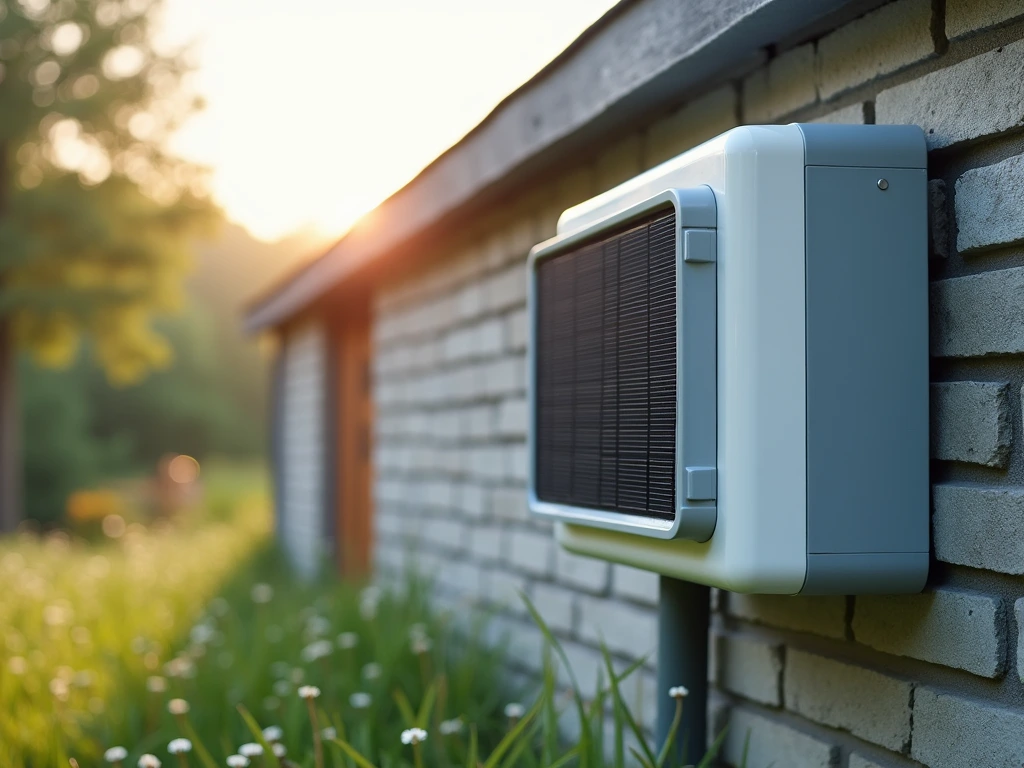
When selecting a solar-powered ventilator, you’ll need to take into account several important factors to guarantee peak performance and longevity. These factors include the power output and battery capacity, which determine the unit’s runtime and effectiveness; the efficiency of the solar panel, which affects charging speed and overall energy conversion; and the ventilation performance, measured in cubic feet per minute (CFM). Additionally, you’ll want to evaluate the durability and weather resistance of the ventilator, as well as its ease of installation and portability, to make sure it meets your specific needs and environmental conditions.
Power and Battery Capacity
Power and battery capacity are vital factors to take into account when selecting a solar-powered ventilator. The power output of these devices typically ranges from 10W to 20W, considerably influencing their efficiency and performance across various applications. You’ll need to evaluate the battery capacity, which can vary from 6600mAh to 12000mAh, as this directly impacts the ventilator’s operational duration during non-sunny hours. Opt for models with efficient solar cells, such as those boasting a 20% efficiency rating, to enhance charging capabilities and improve performance in direct sunlight.
When evaluating battery life, you’ll find that operating time on a full charge can range from 8 to 38 hours, depending on the model and battery size. It’s essential to assess your specific needs and choose a ventilator that aligns with your usage requirements. Additionally, examine models with the ability to charge simultaneously while in use, as this feature enables continuous operation during extended periods of sunlight. By carefully weighing these power and battery factors, you’ll be better equipped to select a solar-powered ventilator that meets your cooling needs efficiently and sustainably.
Solar Panel Efficiency
With solar panel efficiency, you’re looking at an essential factor in the performance of your solar-powered ventilator. The type of solar cells used in the panel considerably impacts its efficiency, with monocrystalline silicon panels typically offering higher efficiency rates, often around 20% or more, compared to polycrystalline alternatives. When selecting a ventilator, prioritize models with enhanced light absorption capabilities, as this can lead to faster charging and improved operation across varying sunlight conditions.
Consider the output power of the solar panel, measured in watts, as it directly affects energy generation. For instance, a 20W panel will outperform a 10W panel, providing longer operating times for your ventilator. Proper alignment and angle of the solar panel are vital; even slight misalignments can result in reduced performance. Confirm the ventilator’s design allows for ideal panel positioning to maximize sunlight exposure. Be aware that panel efficiency may decrease during cloudy weather or when covered in dirt, emphasizing the importance of regular maintenance and strategic placement. By carefully evaluating these factors, you’ll select a solar-powered ventilator that delivers consistent, efficient performance for your eco-friendly cooling needs.
Ventilation Performance
The heart of a solar-powered ventilator lies in its ability to move air effectively. When evaluating ventilation performance, you’ll need to take into account several key factors. Air volume is paramount, with top-performing models capable of moving over 115 CFM, suitable for diverse applications like greenhouses or chicken coops. The power output of the solar panel directly influences efficiency, as higher wattage options (e.g., 20W) typically deliver more robust airflow compared to lower-wattage counterparts.
Optimal performance hinges on proper panel positioning and angle, as misalignment can greatly reduce fan speed and overall effectiveness. It’s important to recognize that many models operate without power storage, functioning only in direct sunlight. This characteristic ties performance directly to solar availability throughout the day. Noise levels are another vital consideration, especially for applications like pet houses where minimal disturbance is essential. Some models operate quietly at around 31 dB, striking a balance between efficiency and acoustics. When selecting a solar-powered ventilator, you’ll need to weigh these factors against your specific requirements, ensuring the chosen model aligns with your ventilation needs and environmental conditions.
Durability and Weather Resistance
Solar-powered ventilators must withstand nature’s unpredictable forces to maintain their effectiveness over time. When selecting a unit, prioritize models with high waterproof ratings, such as IPX7 or IP65, to guarantee protection against rain and moisture infiltration. Opt for ventilators constructed from durable materials like ABS or monocrystalline silicon, which offer superior impact resistance and longevity in harsh outdoor environments. Carefully evaluate the manufacturer’s specified operating temperature range to assure peak performance in extreme heat or cold conditions.
To enhance durability and weather resistance, look for ventilators equipped with protective features such as grilles or backdraft valves. These components prevent debris and pest intrusion when the fan is inactive, preserving the unit’s internal components. Additionally, assess the solar panel’s construction quality, focusing on advanced coatings and efficient light absorption capabilities. These characteristics notably impact the ventilator’s performance across varied weather conditions. By meticulously considering these factors, you’ll select a solar-powered ventilator that not only provides efficient cooling but also maintains its integrity and functionality throughout prolonged exposure to diverse environmental challenges, guaranteeing a reliable and long-lasting investment in eco-friendly ventilation technology.
Installation and Portability
When selecting a solar-powered ventilator, installation ease and portability should top your list of considerations. Evaluate the product’s mounting options, which may include collar fixation for thin surfaces or screw fixation for thicker walls. This flexibility allows for ideal placement based on your specific spatial requirements. Look for models equipped with adjustable brackets or connection cables, as these features enable you to fine-tune the panel’s position for maximum sunlight exposure, guaranteeing efficient operation throughout the day.
The ventilator’s weight and dimensions play an important role in its portability. Lighter models offer greater versatility, allowing for easy transport and installation in various locations. Consider the installation process itself; some units boast plug-and-play functionality, while others may necessitate a more complex setup. For outdoor applications, pay close attention to the waterproof rating (IP rating) to confirm the ventilator can withstand environmental elements. A higher IP rating indicates better protection against water and dust ingress, which is essential for maintaining performance and longevity in exposed areas. By carefully evaluating these factors, you’ll be able to select a solar-powered ventilator that not only meets your cooling needs but also offers hassle-free installation and relocation options.
Additional Features
Beyond installation and portability, several additional features can greatly enhance the functionality and convenience of your solar-powered ventilator. Battery capacity is an essential factor to evaluate, with higher-capacity options, such as 12000mAh units, providing extended operating times ranging from 9 to 38 hours on a full charge. You’ll want to look for adjustable speed settings and timer options, which allow for customizable airflow and energy conservation during use. Dual USB ports or alternative emergency power sources are valuable additions, enabling you to charge essential devices like cell phones and flashlights during outdoor activities.
For outdoor installations, it’s imperative to check the waterproof rating, such as IPX7, to guarantee durability and functionality in various weather conditions. Additionally, assess the noise level of the fan, as lower decibel ratings (e.g., 31 dB) are more suitable for quiet environments like pet houses or greenhouses. By carefully evaluating these features, you’ll be able to select a solar-powered ventilator that not only meets your specific cooling needs but also provides added versatility and reliability in diverse settings and situations.
Price and Value
Selecting the right solar-powered ventilator involves carefully weighing price against value. With prices ranging from $50 to $200, you’ll need to take into account several factors to guarantee you’re getting the best return on your investment. First, examine the solar panel’s efficiency rating; opt for models with ratings of 20% or higher, as these will provide superior performance and extended operational times. Next, evaluate the inclusion of rechargeable batteries, which enhance versatility by allowing nighttime use or operation during overcast conditions.
Durability is another vital aspect of value assessment. Look for ventilators with high waterproof ratings, such as IP65 or above, to confirm longevity and reduce the likelihood of repairs or replacements. When comparing models, analyze the airflow capacity (measured in CFM) in relation to the price. This metric will help you determine if you’re getting adequate ventilation for your specific needs at a reasonable cost. By meticulously evaluating these factors—solar panel efficiency, battery inclusion, durability ratings, and airflow capacity—against the price point, you’ll be well-equipped to select a solar-powered ventilator that offers the best value for your particular application.
Frequently Asked Questions
How Long Does It Take to Fully Charge a Solar-Powered Ventilator?
Much like Icarus harnessing the sun’s power, you’ll find that charging a solar-powered ventilator depends on several factors. Typically, it takes 6-10 hours of direct sunlight to fully charge, but this varies based on the panel’s efficiency, battery capacity, and solar intensity. High-efficiency monocrystalline panels may charge faster, while cloudy conditions extend charging time. Some models feature built-in lithium-ion batteries, which can hold a charge for 24-48 hours, ensuring continuous operation during low-light periods.
Can Solar-Powered Ventilators Work Effectively on Cloudy or Rainy Days?
Solar-powered ventilators can function on cloudy or rainy days, but their efficiency is reduced. You’ll experience diminished performance due to decreased solar energy absorption. Many units incorporate backup batteries, allowing operation during low-light conditions. However, prolonged periods of insufficient sunlight may deplete these reserves. To optimize performance, you should consider models with high-capacity batteries, efficient photovoltaic cells, and energy-saving features. Additionally, some advanced systems integrate weather forecasting algorithms to adjust power consumption based on predicted solar availability.
Are Solar-Powered Ventilators Suitable for Use in Extreme Temperatures?
Like Icarus’s wings, solar-powered ventilators can face challenges in extreme temperatures. You’ll find they’re designed to withstand a wide range of conditions, typically operating between -20°C to 60°C (-4°F to 140°F). High-quality units employ thermal management systems, such as heat sinks and protective coatings, to maintain efficiency. However, in severe heat, panel efficiency may decrease slightly. Conversely, extreme cold can affect battery performance. It’s essential to select models with appropriate IP ratings and temperature-resistant components for your specific climate.
What Is the Average Lifespan of a Solar-Powered Ventilator?
You’ll find that the average lifespan of a solar-powered ventilator typically ranges from 10 to 15 years, depending on factors such as build quality, maintenance, and environmental conditions. The photovoltaic (PV) panels often last 20-25 years, while the fan motor’s longevity is usually 8-12 years. Regular cleaning, lubrication, and protection from extreme weather can greatly extend the unit’s operational life. It’s important to mention that the battery, if present, may require replacement every 3-5 years to maintain ideal performance.
Can Solar-Powered Ventilators Be Used Indoors With Indirect Sunlight?
“Where there’s a will, there’s a way” aptly describes using solar-powered ventilators indoors. You can indeed utilize these devices with indirect sunlight, though efficiency may decrease. Positioning the solar panel near a window or using an extension cable to place it outdoors can maximize energy capture. Some models feature built-in batteries, allowing operation during low-light conditions. It’s essential to evaluate your specific indoor environment, available light, and the ventilator’s specifications to guarantee peak performance.

